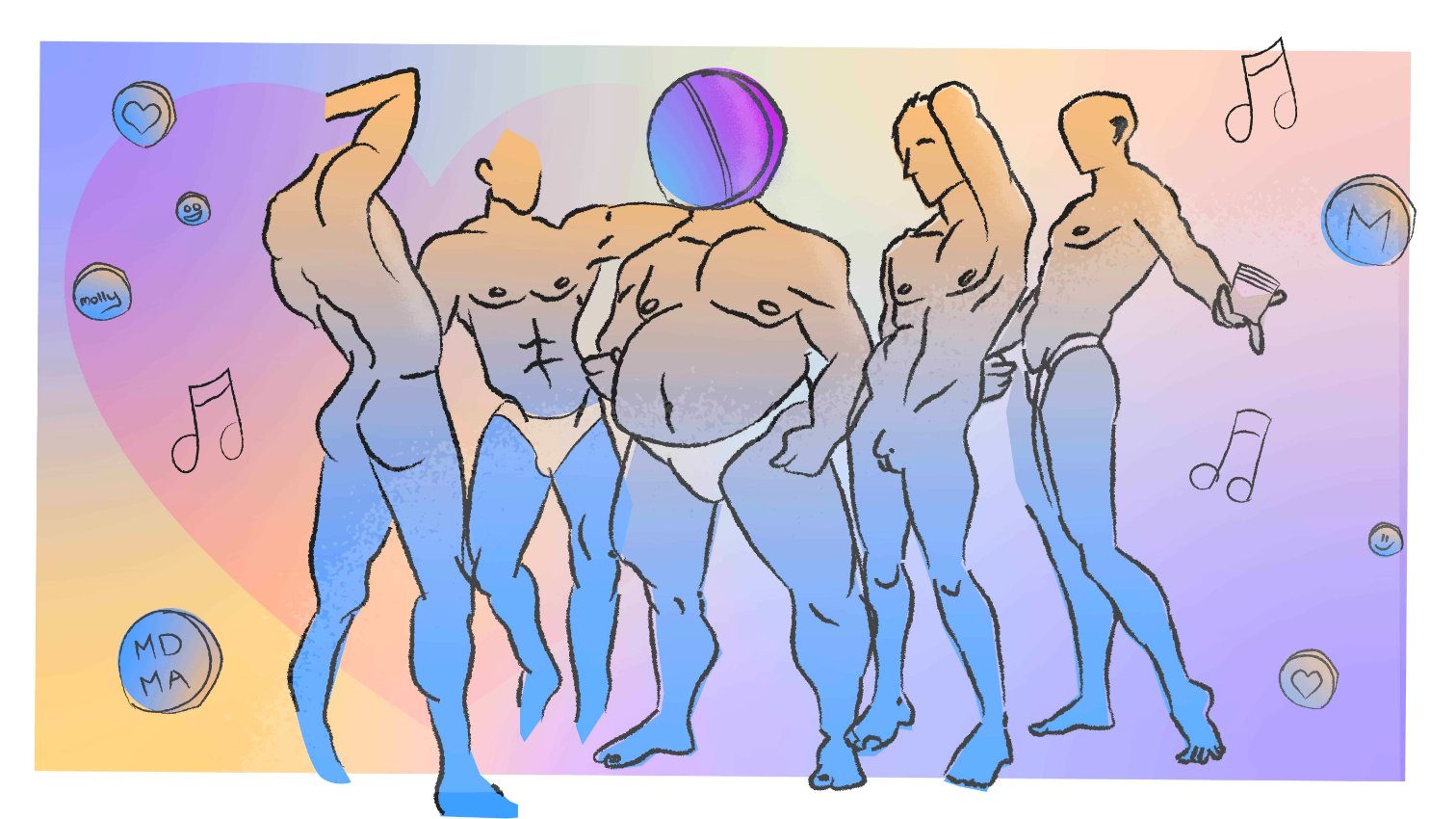
Quick facts 
MDMA (3,4-methylenedioxymethamphetamine) is often referred to as Molly or Mandy. Ecstasy is a collective term for MDMA and similar substances, commonly called E. Emojis like 🍬 may be used to represent MDMA
⬆️ MDMA/Ecstasy has both stimulant and hallucinogenic properties and is used for its euphoric and empathy-enhancing effects
🔴 There is a risk that users may develop psychological dependence, as they can feel a strong desire to relive the positive feelings associated with MDMA/Ecstasy
What is it?
Ecstasy can be a mixture of other drugs, sometimes containing very little or no MDMA at all. Other substances with similar properties may be added instead. MDMA is a centrally acting synthetic substance with mild hallucinogenic properties. As MDMA is a modified amphetamine molecule, it shares similar characteristics with amphetamine.
MDMA/Ecstasy became a popular party drug in Sweden during the 1980s and 1990s. These substances affect the brain’s serotonin production, which can lead to intense feelings of happiness and well-being.
Today, the drug is popular in the nightclub scene but is also used in chemsex to enhance sexual experiences and social interactions.
What does it look like?
MDMA/Ecstasy can appear in various forms, including colorful tablets with different symbols and designs, white or brown crystals, and less commonly as powder or in capsules.
The variation in appearance makes it difficult to know exactly what it is. The content can vary significantly, making it hard to dose correctly and avoid unexpected effects.
Ecstasy tablets often contain much higher doses than the effective dose of MDMA and do not always contain MDMA at all. The tablets may include other substances such as amphetamine, methamphetamine, mephedrone, ketamine, etc. Even tablets that look identical can have different contents.
How is it taken?
MDMA/Ecstasy can be swallowed in tablet form. Crystals can be rolled in paper, such as Rizla rolling paper, a method often referred to as “bombing.”
It is also common to dip a finger into the bag to swallow MDMA crystals. However, there is a risk of overdose when dipping, as it’s not always clear how much is being taken or how often.
MDMA in powder form can also be snorted.
Injecting or inhaling MDMA/Ecstasy is less common.
🕐 When MDMA is swallowed, it can take 30 minutes or longer to feel the effects. The effects of MDMA typically last between 3 and 6 hours. If MDMA is snorted, the effects are felt within a few minutes but last for a shorter duration (about 1-3 hours).
How does it feel?
MDMA produces an intense feeling of euphoria and well-being. Users often experience increased energy, empathy, and social interaction.
One’s own emotions and sensory perceptions are heightened, making individuals feel more “connected” to others, open, happy, and relaxed. Music and physical touch are perceived differently and can feel more enjoyable. The energy and euphoric state create a strong desire to move. MDMA can also induce a feeling of warmth and an increased heart rate.
🕐 The effects of MDMA last between 3 to 6 hours.
☁️ MDMA depletes serotonin reserves in the brain, which can lead to feelings of sadness, irritability, fatigue, or difficulty concentrating after use. These effects can persist for several days due to the temporary decrease in serotonin levels. It takes about a week for serotonin reserves to be restored.
Serotonin is a neurotransmitter in the brain with various functions, including balancing emotions such as hunger, joy, irritation, anger, well-being, and zest for life. Disruptions in serotonin balance can lead to deep depression, psychotic symptoms, and exhaustion.
MDMA/Ecstasy and sex
MDMA is used in sexual contexts due to its ability to enhance euphoria, empathy, and emotional closeness. Users report increased sexual arousal and enjoyment, as well as a heightened sense of intimacy with their partners.
MDMA can also reduce inhibitions and increase feelings of trust, which may lead to more exploratory and experimental sexual experiences. This can result in risky behaviors, such as not using condoms or crossing personal boundaries regarding comfort.
In chemsex contexts, MDMA is often combined with other substances to prolong and intensify sexual experiences. However, MDMA can make it more difficult to achieve or maintain an erection and may also complicate orgasm, prompting many to combine it with Viagra. This combination carries risks related to cardiovascular health.
Safer sex with MDMA/Ecstasy:
- Avoid combining MDMA and Viagra
- If using a condom during sex, change it after 30 minutes to prevent tearing or breakage
- Ensure you have necessary items, such as condoms, lubricant, gloves, and cleaning supplies for toys
- Don’t forget to take breaks and stay hydrated
Side effects and long-term consequences
The side effects of MDMA can vary based on its composition and can differ from person to person. Some common side effects include:
- Increased heart rate
- Excessive sweating
- Headaches
- Dizziness
- Nausea
- A sensation of tingling or crawling in the body (a feeling of wanting to stretch or move)
- Jaw clenching and teeth grinding
- Dry mouth
Users often do not feel hungry, thirsty, or the need to urinate, which can lead to low blood sugar levels, overheating, dehydration, and circulatory collapse.

With regular use over several weeks or months, individuals may experience withdrawal symptoms such as fatigue and irritability. Long-term issues may include sleep difficulties, depression, and anxiety. Memory problems and challenges in learning new things can also occur. These side effects can persist for an extended period, even after discontinuing MDMA/Ecstasy use.
Managing an overdose

- Extreme overheating
- Seizures and muscle rigidity
- Severe anxiety, panic attacks, or hallucinations
- Agitation and confusion
- Unconsciousness
- High blood pressure and heart problems
- Severe dehydration
Signs of serotonin syndrome (one or more symptoms may be present):
- Muscle twitching and exaggerated reflexes
- Involuntary muscle spasms
- Muscle rigidity and fever (serious symptoms)
- Rapid, rhythmic muscle twitches
- Rapid eye movements along with agitation or excessive sweating
- Muscle twitches triggered by stimulation along with agitation or excessive sweating
Always take signs of overdose very seriously. If an overdose is suspected:
- Call for an ambulance: Dial 112, Sweden’s emergency number, which also works in all EU countries. Inform them that you suspect an overdose and describe the symptoms as accurately as possible. It’s crucial to be honest about what and how much the person has taken, as this helps medical staff provide the right care quickly
- Keep the person awake and calm: If possible, try to keep the person awake and calm. Ensure they are breathing and keep their airways clear. Sit or lay them in a comfortable position. If they are unconscious, place them in the recovery position to keep the airways clear and reduce the risk of choking
- Keep the person cool: Ensure the person is in a cool environment; you can open windows, doors, or turn on a fan. Use cool, damp towels on areas where major blood vessels are close to the skin, such as the neck, forehead, armpits, and groin. Offer water in small amounts. Avoid using extremely cold water or ice directly on the skin, as this can worsen the condition
- In case of seizures: Protect the person from injury during the seizure, but do not hold them down. Place something soft under their head, ensuring it doesn’t obstruct their breathing. After the seizure, lay the person on their side with their head slightly tilted back (this helps with breathing and allows saliva to drain from the mouth)
- Stay with the person: Regularly check their breathing and pulse. If breathing becomes irregular or stops, or if the pulse is weak or cannot be felt, you may need to perform CPR. If you’re unsure how to do this, follow the instructions from the emergency operator (112)
🔗 Addiction risk
Even though MDMA/Ecstasy is not considered as addictive as some other drugs, there is a risk of psychological dependence. Users may develop a strong craving for the positive feelings the drug provides, which can lead to repeated use. Over time, this can result in tolerance, where higher doses are needed to achieve the same effects.
MDMA/Ecstasy affects the brain’s serotonin system, which can lead to long-lasting changes in mood and behavior. After use, many experience a drop in mood, known as “Tuesday anxiety,” “Tuesday suicide,” or “ecstasy blues.” This decline in mood can drive further use to avoid negative feelings.
Repeated and frequent use of MDMA/Ecstasy can lead to serious health problems, including memory loss, sleep difficulties, and anxiety.
MDMA/Ecstasy och other drugs
MDMA combined with other substances can pose risks, in the worst case leading to serious medical complications or even death.
Alcohol
Combining MDMA with alcohol can be particularly dangerous.
- Alcohol can enhance the dehydrating effects of MDMA, increasing the risk of overheating (hyperthermia) and dehydration
- It can also dull the body’s warning signals, making it harder to recognize dangerous side effects from MDMA
Stimulants 
- This combination significantly increases the risk of heart problems. These drugs can overload the heart, leading to irregular heartbeats and, in severe cases, heart attack
Depressants 
- Combining MDMA with depressants can be extremely dangerous
- Depressant drugs slow down the body’s functions and can counteract the stimulating effects of MDMA, increasing the risk of respiratory difficulties and overdose
MDMA/Ecstasy and antidepressants
Treatment with antidepressants that affect serotonin levels (e.g., SSRIs or SNRIs) can alter or block the effects of MDMA/Ecstasy.
In cases of MDMA/Ecstasy overdose, or when combining high doses of antidepressants with Ecstasy, there is a small but serious risk of serotonin syndrome, which is a life-threatening condition. The risk of developing this syndrome is individual and depends on how quickly the medications are metabolized.
MDMA/Ecstasy and HIV-treatment (ART)
MDMA can negatively impact the immune system, which is particularly problematic for individuals with HIV, who already have a weakened immune response. The use of MDMA may increase the risk of infections and impair the body’s ability to combat viruses and other pathogens.
MDMA can also affect adherence to HIV medications. The euphoric and sometimes confusing effects of the drug may lead individuals to forget to take their medications regularly, which is crucial for keeping viral levels under control.
Specific HIV Medications: The use of booster medications like ritonavir and cobicistat can slow down the metabolism of MDMA, meaning it stays in the bloodstream longer and maintains higher concentrations for an extended period. This can increase the risk and intensity of MDMA side effects.
🕐 Make sure to have your HIV medications with you. If you often forget to take your medicine, set an alarm or reminder on your phone. Take substances and HIV medications at different times to reduce the risk of side effects. Always use low doses of substances when taking medications simultaneously.
🗣️ Talk to your doctor or someone knowledgeable about interactions between HIV medications and MDMA/Ecstasy.


